Estimation of Avalanche Development and Frontal Velocities Based on the Spectrogram of the Seismic Signals Generated at the Vallée de la Sionne Test Site
Abstract
1. Introduction
2. Vallée de la Sionne (VdlS) Test Site, Instrumentation, and Avalanche Events
3. Data Processing
4. Avalanche Seismic Signal Evolution
5. Methodology and Quantification
5.1. Quantification of the Spectrogram SON Section
5.1.1. Curves at B
5.1.2. Curves at C
5.1.3. Evolution of Curves from B to C
5.2. Avalanche Speed Estimation
6. Discussion
6.1. Avalanche Evolution
6.2. Averaged Curves
6.3. Front Avalanche Speed Estimation
7. Conclusions
Supplementary Materials
Author Contributions
Funding
Acknowledgments
Conflicts of Interest
Appendix A. Seismic Signal Transformation
Appendix A.1. Seismic Signal in the Slope Direction Transformation
Appendix A.2. Seismic Signal in Polar Coordinates Transformation

Appendix B
B.1. Transitional Avalanche (TRANS)
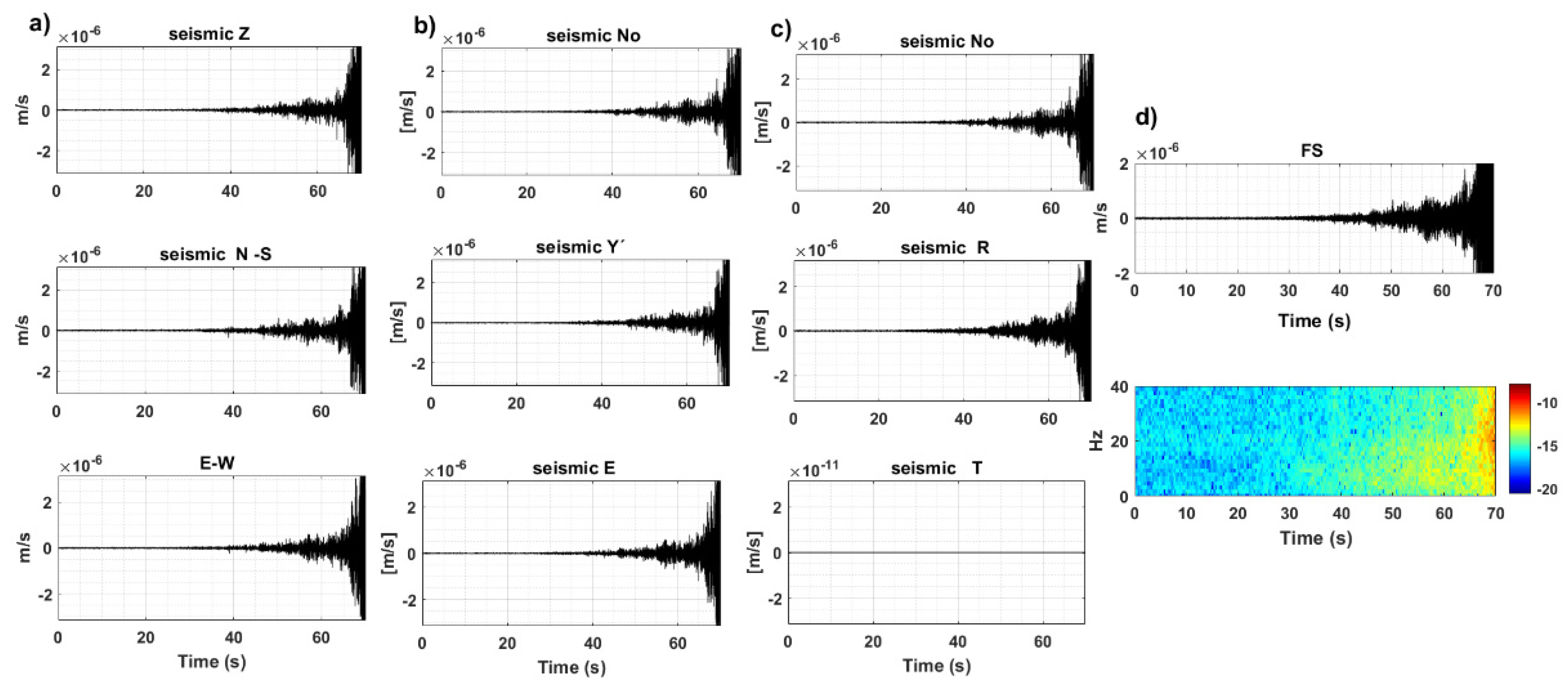
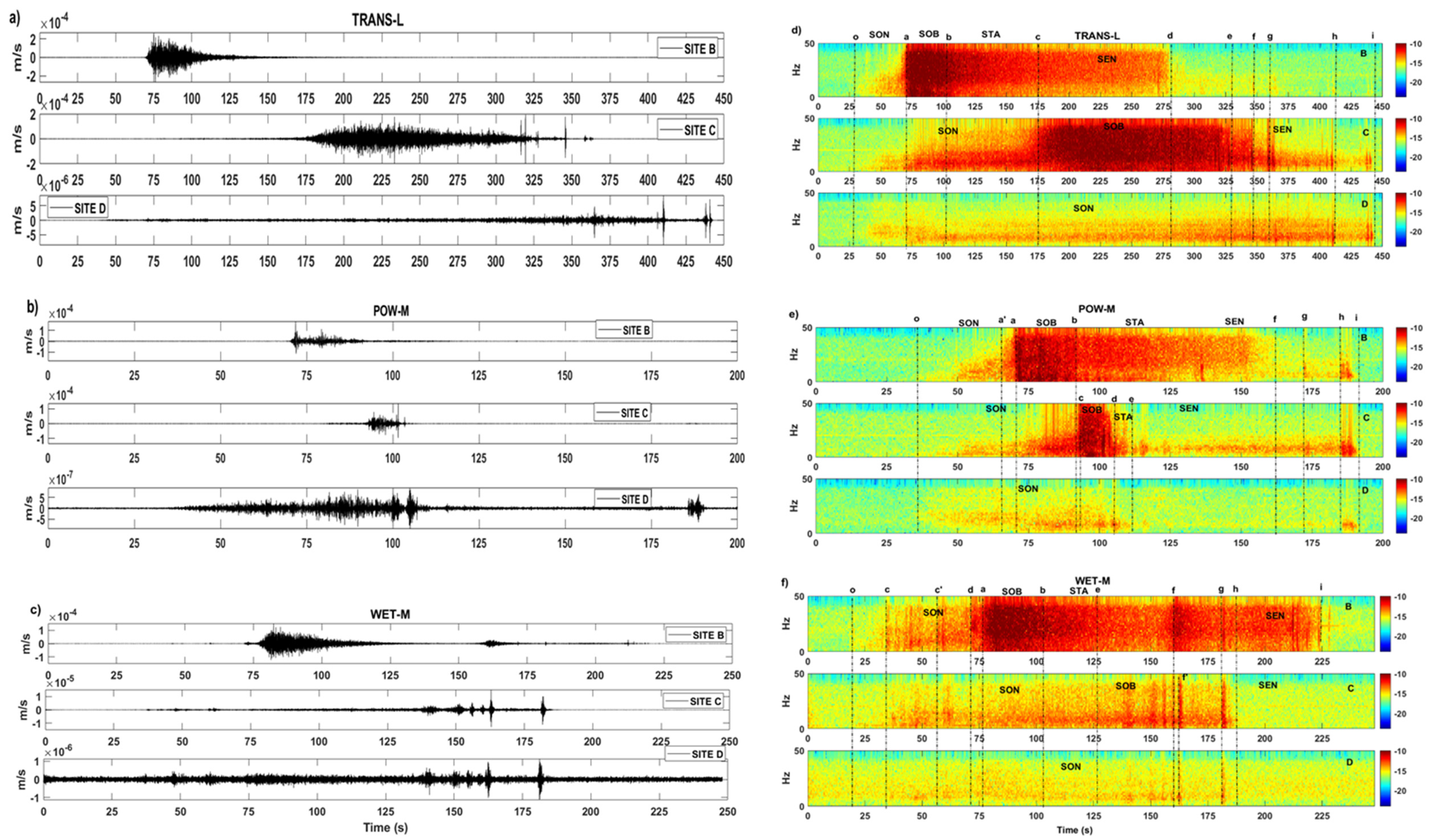
B.2. Powder-Snow Avalanche (POW)
B.3. Wet-Snow Avalanche (WET)
| TRANS- L | POW- M | WET-M | ||||||||||||
|---|---|---|---|---|---|---|---|---|---|---|---|---|---|---|
| OF | Time (s) | DURATION (s) | Av. Speed (m/s) | OF | Time (s) | DURATION (s) | Av. Speed (m/s) | OF | Time (s) | DURATION (s) | Av. Speed (m/s) | |||
| SON_B | o | 32 | o-a | SON (o-a) | SON_B | o | 36 | o-a | SON (o-a) | SON_B | o | 19 | o-d | SON (o-a) |
| 38 | 26 | a’ | 66 | 34 | 29 | c | 34 | 52 | 17 | |||||
| a-c | B-C | a-c | B-C | c’ | 57 | o-a | ||||||||
| 105 | 6.6 | 23 | 30 | d | 71 | 57 | ||||||||
| SOB_B | a | 70 | a-b | SOB_B | a | 70 | a-b | SOB_B | a | 76 | a-b | |||
| 35 | STA_B | b | 92 | 22 | 28 | |||||||||
| a-d | b-f | STA_B | b | 104 | a-e | |||||||||
| 208 | SEN_B | f | 160 | 68 | e | 127 | 51 | |||||||
| STA_B | b | 105 | o-d | a-h | f | 159 | ||||||||
| 246 | g | 171 | 114 | o-i | ||||||||||
| d-b | o-h | 206 | ||||||||||||
| SEN_B | d | 278 | 173 | h | 184 | 148 | END_B | i | 225 | b-i | ||||
| i | 191 | o-i | SEN_B | 121 | ||||||||||
| SON_C | o | 32 | o-c | 155 | ||||||||||
| 143 | SON_C | o | 19 | o-h | ||||||||||
| a-c | SON_C | o | 36 | o-c | 167 | |||||||||
| 105 | 57 | STA_C | f’ | 163 | ||||||||||
| SOB_C | c | 175 | c-e | SOB_C | c | 93 | c-d | g | 181 | a-i | ||||
| 153 | d | 103 | 10 | h | 186 | 149 | ||||||||
| STA_C | e | 328 | c-f | STA_C | e | 110 | d-e | |||||||
| f | 348 | 173 | 7 | SON_D | c | 34 | ||||||||
| g | 358 | c-g | g | 171 | STA_D | f’ | 163 | |||||||
| 183 | SEN_C | h | 184 | e-h | g | 181 | ||||||||
| h | 410 | c-i | i | 191 | 74 | |||||||||
| SEN_C | i | 441 | 266 | o-i | ||||||||||
| o-i | 155 | |||||||||||||
| 409 | ||||||||||||||
| SON_D | o | 32 | o-i | SON_D | o | 36 | o-e | |||||||
| h | 410 | 409 | e | 110 | 74 | |||||||||
| SEN_D | i | 441 | h | 184 |
References
- Lawrence, W.S.; Williams, T.R. Seismic signals associated with avalanches. J. Glaciol. 1976, 17, 521–526. [Google Scholar] [CrossRef][Green Version]
- Salway, A.A. A Seismic and Pressure Transducer System for Monitoring Velocities and Impact Pressure of Snow Avalanches. Arct. Alp. Res. 1978, 10, 769–774. [Google Scholar] [CrossRef][Green Version]
- Shaerer, P.A.; Salway, A.A. Seismic and impact-pressure monitoring of flowing Avalanches. J. Glaciol. 1980, 26, 179–187. [Google Scholar] [CrossRef][Green Version]
- Firstov, P.; Sukhanov, L.; Pergement, V.; Rodionovskiy, M. Acoustic and seismic signal from snow avalanches, Transactions (Doklady) of the U.S.S.R. Acad. Sci. Earth Sci. Sect. 1992, 312, 67–71. [Google Scholar]
- Norris, R.D. Seismicity of Rockfalls and Avalanches at Three Cascade Range Volcanoes: Implications for seismic Detection and hazardous Mass movements. Bull. Seismol. Soc. Am. 1994, 84, 1925–1939. [Google Scholar]
- Leprettre, B.; Navarre, J.-P.; Taillefer, A. First results from a pre-operational system for automatic detection and recognition of seismic signals associated with avalanches. J. Glaciol. 1996, 42, 352–363. [Google Scholar] [CrossRef]
- Suriñach, E.; Furdada, G.; Sabot, F.; Biescas, B.; Vilaplana, J.M. On the characterization of seismic signals generated by snow avalanches for monitoring purposes. Ann. Glaciol. 2001, 32, 268–274. [Google Scholar] [CrossRef]
- Van Herwijnen, A.; Schweizer, J. Monitoring avalanche activity using a seismic sensor. Cold Reg. Sci. Technol. 2011, 69, 165–176. [Google Scholar] [CrossRef]
- Van Herwijnen, A.; Schweizer, J. Seismic sensor array for monitoring an avalanche start zone: Design, deployment and preliminary results. J. Glaciol. 2011, 57, 267–276. [Google Scholar] [CrossRef]
- Hammer, C.; Fäh, D.; Ohrnberger, M. Automatic detection of wet-snow avalanche seismic signals. Nat. Hazards 2017, 86, 601–618. [Google Scholar] [CrossRef]
- Heck, M.; Hammer, C.; Van Herwijnen, A.; Schweizer, J.; Fäh, D. Automatic detection of snow avalanches in continuous seismic data using hidden Markov models. Nat. Hazards Earth Syst. Sci. 2018, 18, 383–396. [Google Scholar] [CrossRef]
- Heck, M.; van Herwijnen, A.; Hammer, C.; Hobiger, M.; Schweizer, J.; Fäh, D. Automatic detection of avalanches combining array classification and localization. Earth Surf. Dyn. 2019, 7, 491–503. [Google Scholar] [CrossRef]
- Lacroix, P.; Grasso, J.-R.; Roulle, J.; Giraud, G.; Goetz, D.; Morin, S.; Helmstetter, A. Monitoring of snow avalanches using a seismic array: Location, speed estimation, and relationships to meteorological variables. J. Geophys. Res. 2012, 117, F01034. [Google Scholar] [CrossRef]
- Heck, M.; Hobiger, M.; van Herwijnen, A.; Schweizer, J.; Fäh, D. Localization of seismic events produced by avalanches using multiple signal classification. Geophys. J. Int. 2018, 216, 201–217. [Google Scholar] [CrossRef]
- Pérez-Guillén, C.; Tsunematsu, K.; Nishimura, K.; Issler, D. Seismic location and tracking of snow avalanches and slush flows on Mt. Fuji, Japan. Earth Surf. Dyn. 2019, 7, 989–1007. [Google Scholar] [CrossRef]
- Vilajosana, I.; Khazaradze, G.; Surinach, E.; Lied, E.; Kristensen, K. Snow avalanche speed determination using seismic methods. Cold Reg. Sci. Technol. 2007, 49, 2–10. [Google Scholar] [CrossRef]
- Vilajosana, I.; Suriñach, E.; Khazaradze, G.; Gauer, P. Snow avalanche energy estimation from seismic signal analysis. Cold Reg. Sci. Technol. 2007, 50, 72–85. [Google Scholar] [CrossRef]
- Vilajosana, I. Seismic Detection and Characterization of Snow Avalanches and Other Mass Movements. Ph.D. Thesis, Universitat de Barcelona, Barcelona, Spain, 2008. [Google Scholar]
- Pérez-Guillén, C.; Sovilla, B.; Suriñach, E.; Tapia, M.; Köhler, A. Deducing avalanche size and flow regimes from seismic measurements. Cold Reg. Sci. Technol. 2016, 121, 25–41. [Google Scholar] [CrossRef]
- Sabot, F.; Martinez, P.; Suriñach, E.; Olivera, C.; Gavalda, J. Detection Sismique Appliquée A la Caracterisation des Avalanches. In Les Apports de la Recherche Scientifique A la Sécurité Neige, Glace et Avalanches; Editions ANENA- CEMAGREF; Éditions Quae: Grenoble, France, 1995; pp. 19–24. [Google Scholar]
- Sabot, F.; Naaim, M.; Granada, F.; Suriñach, E.; Planet-Ladret, P.; Furdada, G. Study of the avalanche dynamics by means of seismic methods, image processing techniques and numerical models. Ann. Glacial. 1998, 26, 19–323. [Google Scholar]
- Suriñach, E.; Sabot, F.; Furdada, G.; Vilaplana, J.M. Study of seismic signals of artificially released snow avalanches for monitoring purposes. Phys. Chem. Earth 2000, 25, 721–727. [Google Scholar] [CrossRef]
- Biescas, B.; Dufour, F.; Furdada, G.; Khazaradze, G.; Suriñach, E. Frequency content evolution of snow avalanche seismic signals. Surv. Geophys. 2003, 24, 447–464. [Google Scholar] [CrossRef]
- Gubler, H.; Hiller, M. The use of microwave FMCW radar in snow and avalanche research. Cold Reg. Sci. Technol. 1984, 9, 109–119. [Google Scholar] [CrossRef]
- Biescas, B. Aplicación de la Sismología al Estudio y Detección de aludes de Nieve. Ph.D. Thesis, Universitat de Barcelona, Barcelona, Spain, 2003. [Google Scholar]
- Ammann, W.J. A new Swiss test-site for avalanche experiments in the Vallée de la Sionne/Valais. Cold Reg. Sci. Technol. 1999, 30, 3–11. [Google Scholar] [CrossRef]
- Sovilla, B.; McElwaine, J.; Steinkogler, W.; Hiller, M.; Dufour, F.; Suriñach, E.; Pérez-Guillén, C.; Fischer, J.T.; Thibert, E.; Baroudi, D. The Full-Scale Avalanche Dynamics Test Site Vallée de la Sionne. In Proceedings of the International Snow Science Workshop, Grenoble, France, 7–11 October 2013; pp. 1350–1357. [Google Scholar]
- Ash, M.; Chetty, K.; Brennan, P.; McElwaine, J.; Keylock, C. FMCW Radar Imaging of Avalanche-Like Snow Movements. In Proceedings of the 2010 IEEE Radar Conference, Arlington, VA, USA, 10–14 May 2010; pp. 102–107. [Google Scholar] [CrossRef]
- Vriend, N.M.; McElwaine, J.N.; Sovilla, B.; Keylock, C.J.; Ash, M.; Brenna, P.V. High resolution radar measurements of snow avalanches. Geophys. Res. Lett. 2013, 40, 727–731. [Google Scholar] [CrossRef]
- Köhler, A.; McElwaine, J.N.; Sovilla, B.; Ash, M.; Brennan, P.V. The dynamics of surges in the 3 February 2015 avalanches in Vallée de la Sionne. J. Geophys. Res. Earth Surf. 2016, 121, 2192–2210. [Google Scholar] [CrossRef]
- Roig-Lafon, P.; Pérez-Guillén, C.; Sovilla, B.; Suriñach, E.; Köhler, A.; Tapia, M.; Furdada, G. Comparative Analysis of Avalanche Seismic Signals and Geodar Data at the Vallée de la Sionne Test Site. In Proceedings of the International Snow Science Workshop, Innsbruck, Austria, 7–12 October 2018; pp. 601–605. [Google Scholar]
- Nishimura, K.; Ito, Y. Velocity distribution in snow avalanches. J. Geophys. Res. 1997, 102, 27297–27303. [Google Scholar] [CrossRef]
- Nishimura, K.; Maeno, N.; Kawada, K.; Izumi, K. Structures of snow cloud in dry-snow avalanches. Ann. Glaciol. 1993, 18, 173–178. [Google Scholar] [CrossRef]
- McElwaine, J.N.; Tiefenbacher, F. Calculating internal avalanche velocities from correlation with error analysis. Surv. Geophys. 2003, 24, 499–524. [Google Scholar] [CrossRef]
- Tiefenbacher, F.; Kern, M.A. Experimental devices to determine snow avalanche basal friction and velocity profiles. Cold Reg. Sci. Technol. 2004, 38, 17–30. [Google Scholar] [CrossRef]
- Sovilla, B.; Schaer, M.; Kern, M.; Bartelt, P. Impact pressures and flow regimes in dense snow avalanches observed at the Vallée de la Sione test site. J. Geophys. Res. 2008, 113, 1–14. [Google Scholar] [CrossRef]
- Sovilla, B.; McElwaine, J.N.; Louge, M.Y. The structure of powder snow avalanches. C. R. Phys. 2015, 16, 97–104. [Google Scholar] [CrossRef]
- Salm, B.; Gubler, H. Measurement and analysis of the motion of dense flow avalanches. Ann. Glacial 1985, 6, 26–34. [Google Scholar] [CrossRef]
- Gubler, H. Measurements and modelling of snow avalanche speeds. IAHS Publ. 1987, 162, 405–420. [Google Scholar]
- Nishimura, K.; Izumi, K. Seismic signals induced with the snow avalanche flow. Nat. Hazards 1997, 15, 89–100. [Google Scholar] [CrossRef]
- Vallet, J.; Turnbull, B.; Jolya, S.; Dufour, F. Observations on powder snow avalanches using videogrammetry. Cold Reg. Sci. Technol. 2004, 39, 153–159. [Google Scholar] [CrossRef]
- Gauer, P. On Avalanche (front) Velocity Measurements at the Ryggfonn Avalanche Test Site and Comparison with Observations from Other Locations. In Proceedings of the International Snow Science Workshop, Anchorage, Alaska, 16–21 September 2012; pp. 427–432. [Google Scholar]
- Gauer, P. Comparison of avalanche front velocity measurements: Supplementary energy considerations. Cold Reg. Sci. Technol. 2013, 96, 17–22. [Google Scholar] [CrossRef]
- Gauer, P. Comparison of avalanche front velocity measurements and implications for avalanche models. Cold Reg. Sci. Technol. 2014, 97, 132–150. [Google Scholar] [CrossRef]
- Gauer, P.; Kern, M.; Kristensen, K.; Lied, K.; Rammer, L.; Schreiber, H. On pulsed Doppler radar measurements of avalanches and their implication to avalanche dynamics. Cold Reg. Sci. Technol. 2007, 50, 55–71. [Google Scholar] [CrossRef]
- Gauer, P.; Issler, D.; Lied, K.; Kristensen, K.; Iwe, H.; Lied, E.; Rammer, L.; Schreiber, H. On full-scale avalanche measurements at the Ryggfonn test site, Norway. Cold Reg. Sci. Technol. 2007, 49, 39–53. [Google Scholar] [CrossRef]
- Rammer, L.; Kern, M.; Gruber, U.; Tiefenbacher, F. Comparison of avalanche-velocity measurements by means of pulsed Doppler radar, continuous wave radar and optical methods. Cold Reg. Sci. Technol. 2007, 50, 35–54. [Google Scholar] [CrossRef]
- Köhler, A.; McElwaine, J.N.; Sovilla, B. GEODAR Data and the Flow Regimes of Snow Avalanches. J. Geophys. Res. Earth Surf. 2018, 123, 1272–1294. [Google Scholar] [CrossRef]
- McElwaine, J.N.; Köhler, A.; Sovilla, B.; Ash, M.; Brennan, P.V. GEODAR data of snow avalanches at Vallée de la Sionne: Seasons 2010/2011, 2011/2012, 2012/2013 & 2014/2015 [Data set]. Zenodo 2017. [Google Scholar] [CrossRef]
- Vilajosana, I.; Llosa, J.; Schaefer, M.; Suriñach, E.; Vilajosana, X. Wireless sensors as a tool to explore avalanche internal dynamics: Experiments at the Weissflühjoch Snow Chute. Cold Reg. Sci. Technol. 2011, 65, 242–250. [Google Scholar] [CrossRef]
- Takeuchi, Y.; Yamanoi, K.; Endo, Y.; Murakami, S.; Izumi, K. Velocities for the dry and wet snow avalanches at Makunosawa valley in Myoko, Japan. Cold Reg. Sci. Technol. 2003, 37, 483–486. [Google Scholar] [CrossRef]
- Schmidt, R. Multiple emitter location and signal parameter estimation. IEEE Trans. Antennas Propag. 1986, 34, 276–280. [Google Scholar] [CrossRef]
- Hough, P.V.C. Method and Means for Recognizing Complex Patterns. U.S. Patent 3069654, 18 December 1962. [Google Scholar]
- AlBinHassan, N.M.; Marfurt, K. Fault detection using Hough transforms. SEG Tech. Expand. Abstr. 2003, 22, 1719–1721. [Google Scholar]
- Rivera-Ríos, A.M.; Flores-Márquez, E.L. Image-radargram analysis based on generalized Hough transform: Experimental cases. J. Geophys. Eng. 2012, 9, 558–568. [Google Scholar] [CrossRef]
- Varun, R.; Kini, Y.V.; Manikantan, K.; Ramachandran, S. Face Recognition using Hough Transform based Feature Extraction. Procedia Comput. Sci. 2015, 46, 1491–1500. [Google Scholar] [CrossRef]
- Pérez- Guillén, C. Advanced Seismic Methods Applied to the Study of Snow Avalanche Dynamics and Avalanche Formation. Ph.D. Thesis, Universitat de Barcelona, Barcelona, Spain, 2016. [Google Scholar]
- Pérez-Guillén, C.; Tapia, M.; Furdada, G.; Suriñach, E.; McElwaine, J.N.; Steinkogler, W.; Hiller, M. Evaluation of a snow avalanche possibly triggered by a local earthquake. Cold Reg. Sci. 2014, 108, 149–162. [Google Scholar]
- Kogelnig, A.; Suriñach, E.; Vilajosana, I.; Hübl, J.; Sovilla, B.; Hiller, M.; Dufour, F. On the complementariness of infrasound and seismic sensors for monitoring snow avalanches. Nat. Hazards Earth Syst. Sci. 2011, 11, 355–2370. [Google Scholar] [CrossRef]
- Brigham, E.O. The Fast Fourier Transform; Prentice Hall, Inc.: Englewood Cliffs, NJ, USA, 1974; p. 252. [Google Scholar]
- Suriñach, E.; Flores-Márquez, E.L.; Roig-Lafón, P.; Pérez-Guillén, C.; Furdada, G.; Tapia, M. Estimated Evolution of the Speed of Powder, Wet and Transitional Avalanches between Two Distant Locations at the VdlS Experimental Site Extracted from the Analysis of Seismic Signals. In Proceedings of the International Snow Science Workshop, Innsbruck, Austria, 7–12 October 2018; pp. 606–610. [Google Scholar]
- Flores-Márquez, E.L.; Suriñach, E. Obtaining information on mass movements from the spectrograms of the seismic signals generated JOSE. submitted.
- Kogelnig, A.; Hübl, J.; Suriñach, E.; Vilajosana, I.; McArdell, I.B.W. Infrasound produced by debris flow: Propagation and frequency content evolution. Nat. Hazards 2014, 70, 1713–1733. [Google Scholar] [CrossRef]
- Vázquez, R.; Suriñach, E.; Capra, L.; Arámbula-Mendoza, R.; Reyes-Dávila, G. Seismic characterisation of lahars at Volcán de Colima, México. Bull. Volcanol. 2016, 78, 8. [Google Scholar] [CrossRef]
- Aki, K.; Richards, P.G. Quantitative Seismology: Theory and Methods; University Science Books: Sausalito, CA, USA, 1980. [Google Scholar]
- Ridler, T.W.; Calvard, S. Picture thresholding using an iterative selection method. IEEE Trans. Syst. Man Cybern. 1978, 8, 630–632. [Google Scholar] [CrossRef]
- Saló, L.; Corominas, J.; Lantada, N.; Matas, G.; Prades, A.; Ruiz-Carulla, R. Seismic Energy Analysis as Generated by Impact and Fragmentation of Single-Block Experimental Rockfalls. J. Geophys. Res. Earth Surf. 2018, 123, 1450–1478. [Google Scholar] [CrossRef]
- Suriñach, E.; Tapia, M.; Roig, P.; Blach, X. On the effect of the ground seismic characteristics in the estimation of mass movements based on seismic observation. Geophys. Res. Abstracts 2018, 20, EGU2018–EGU8479. [Google Scholar]
- Levy, C.; Mangeney, A.; Bonilla, F.; Hibert, C.; Calder, E.S.; Smith, P.J. Friction weakening in granular flows deduced from seismic records at the Soufrière Hills Volcano, Montserrat. J. Geophys. Res. Solid Earth 2015, 120, 7536–7557. [Google Scholar] [CrossRef]
- Pilz, M.; Fäh, D. The contribution of scattering to near-surface attenuation. J. Seismol. 2017, 21, 837–855. [Google Scholar] [CrossRef]
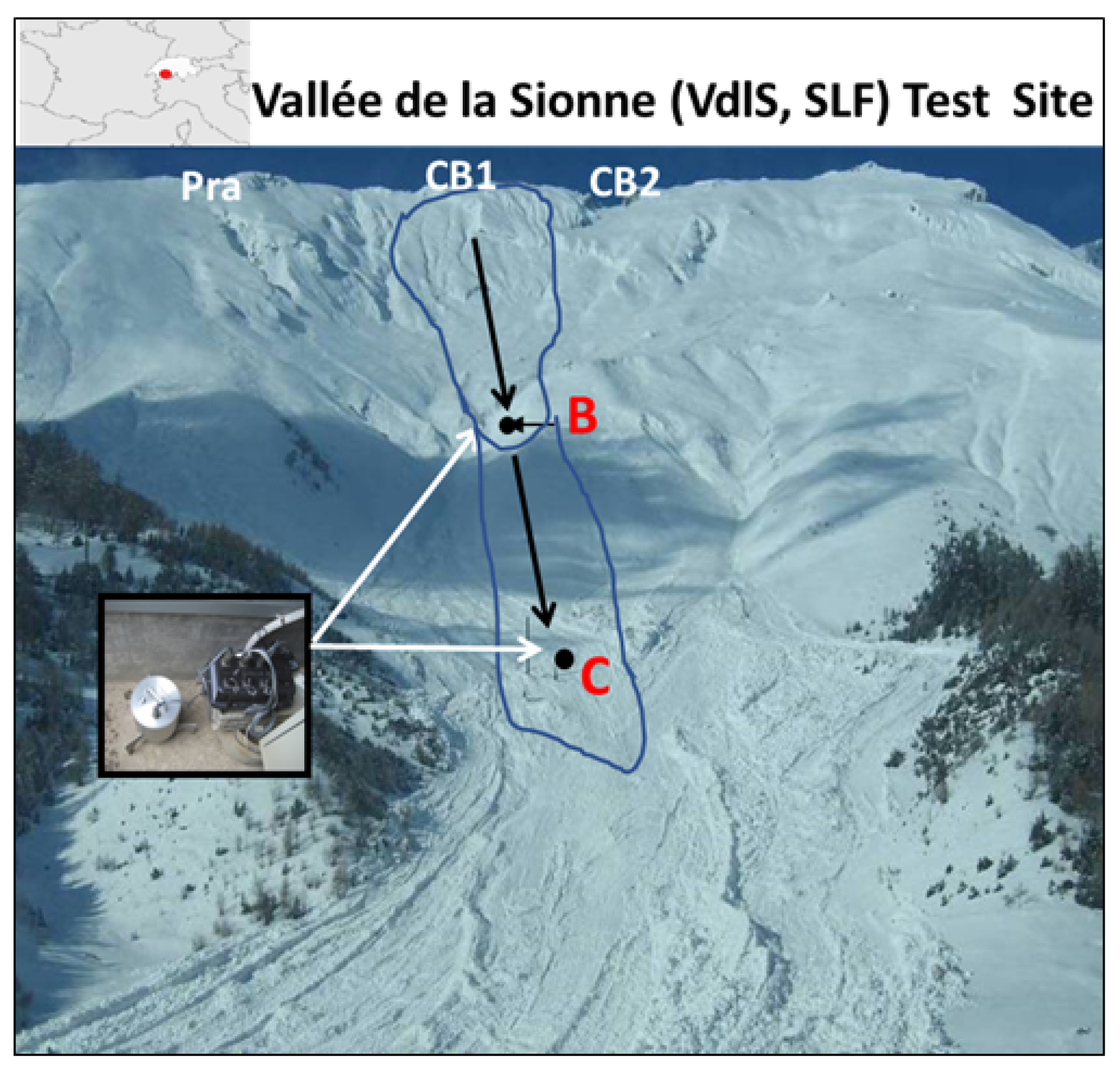
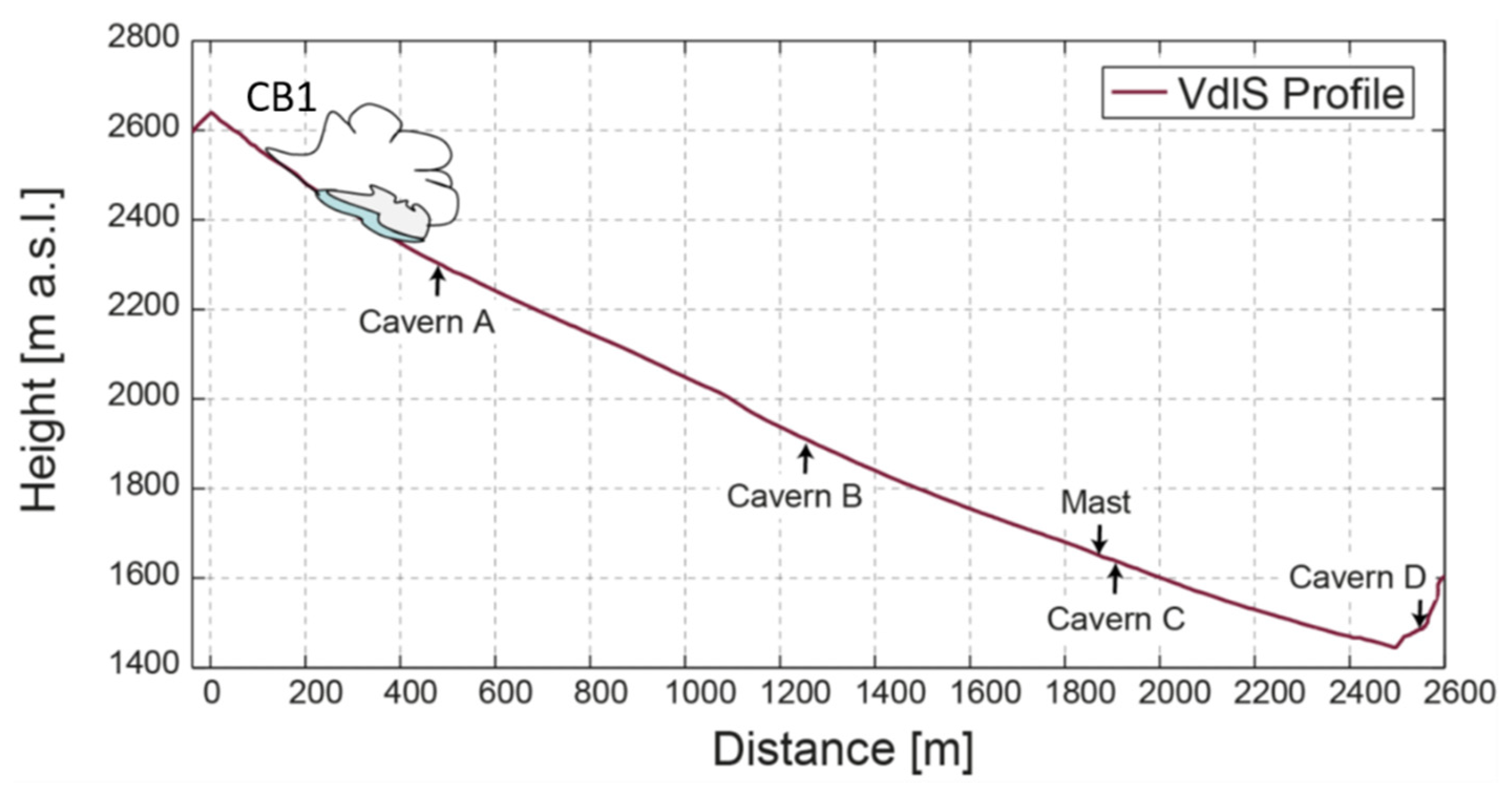
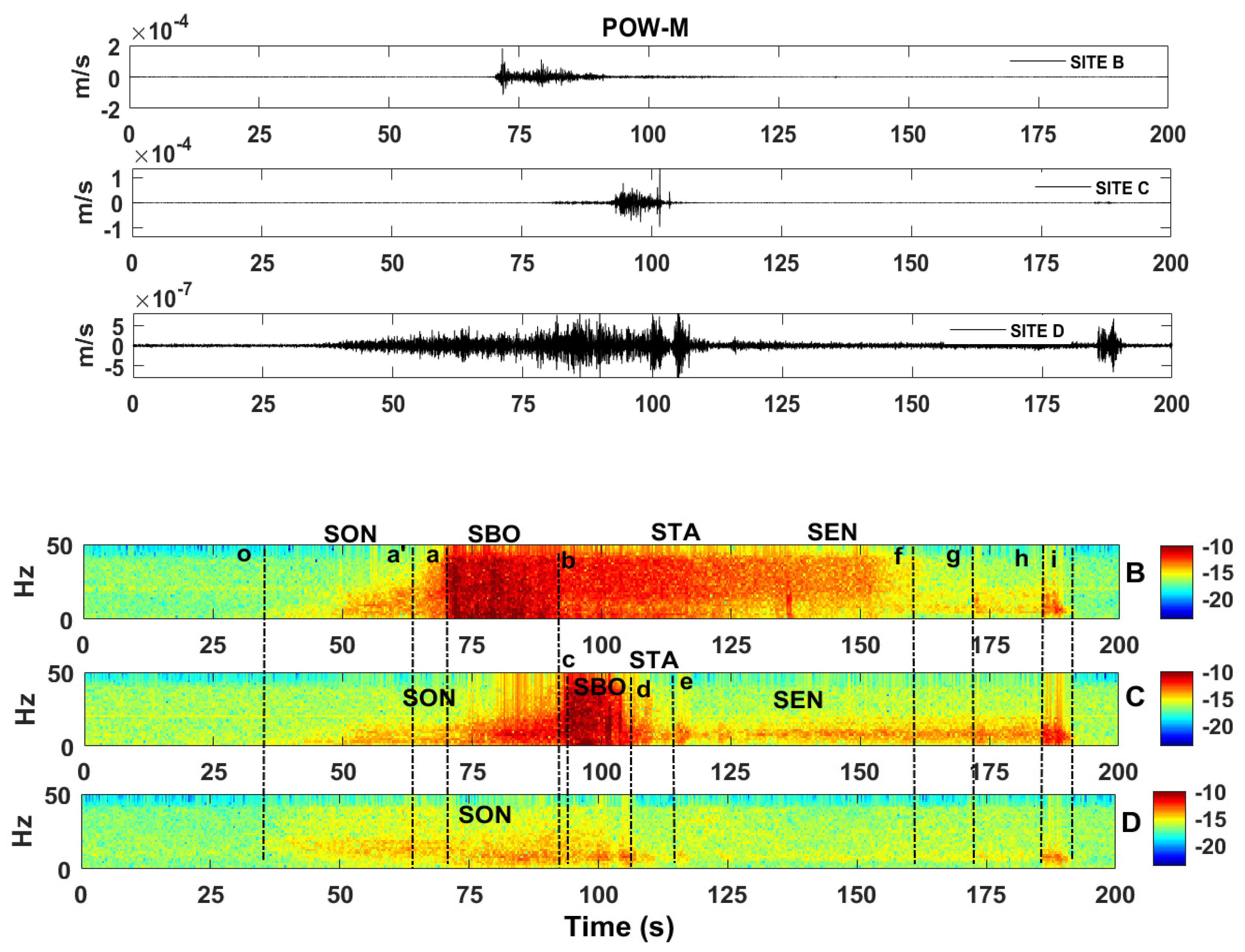
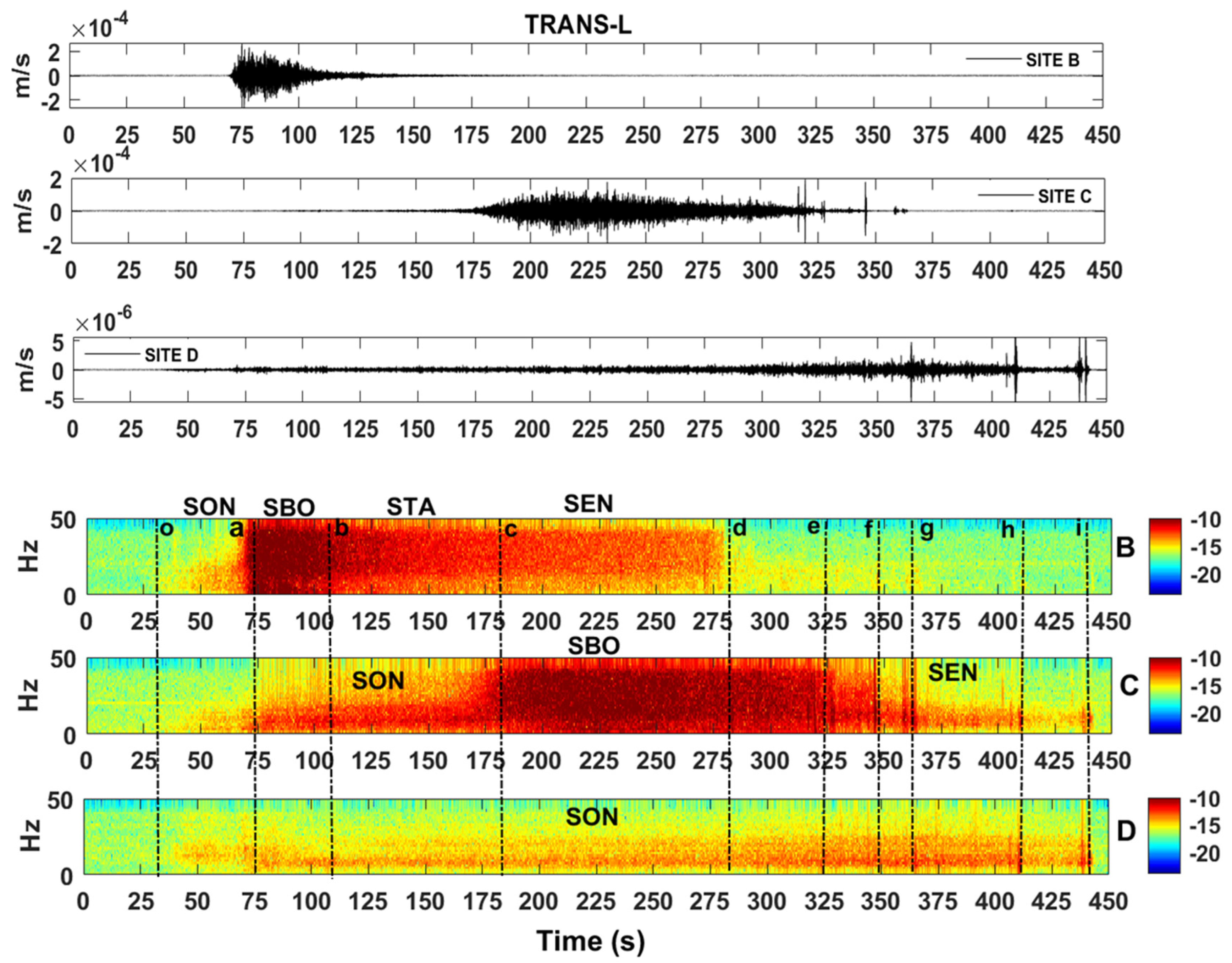
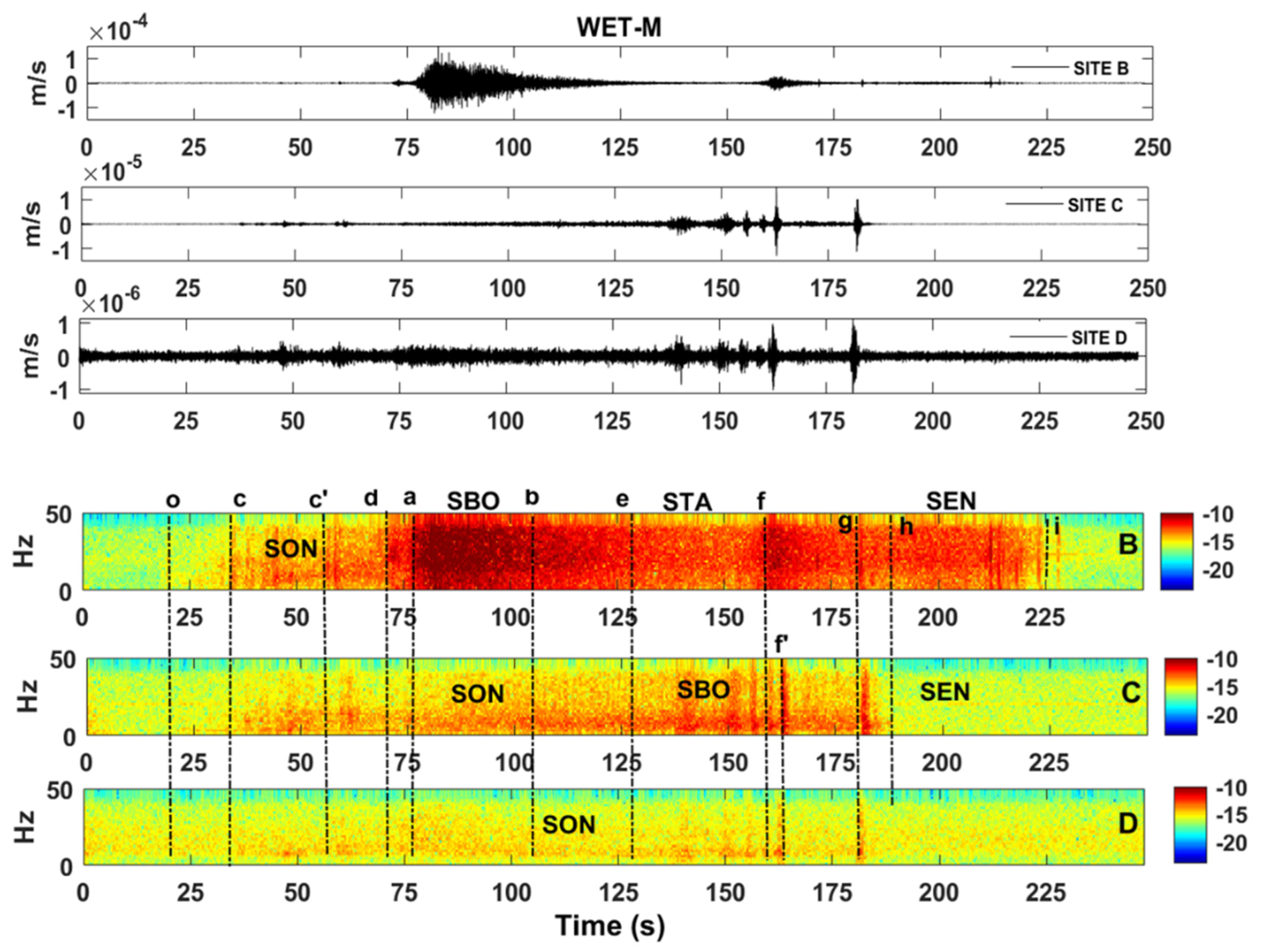
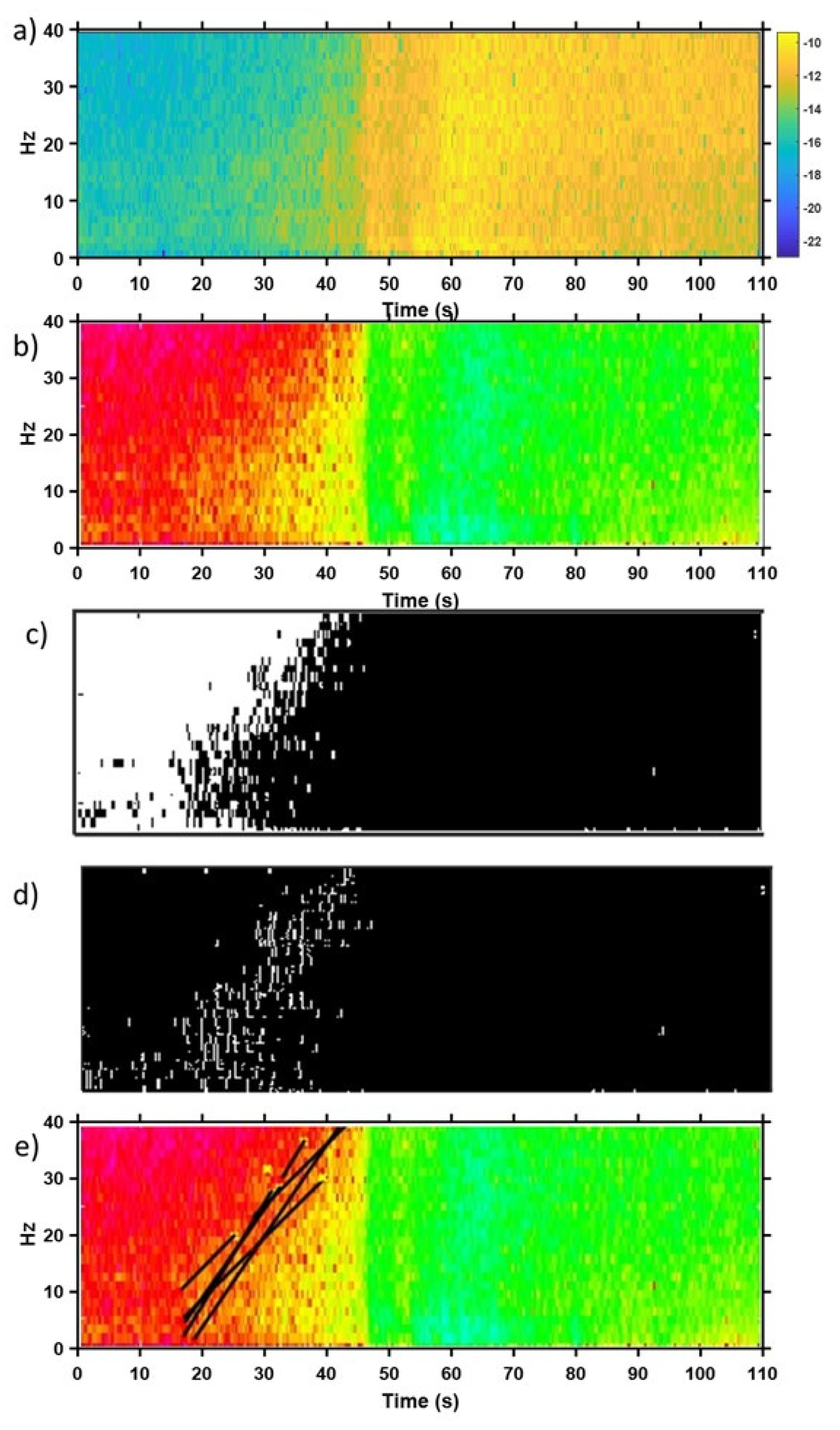
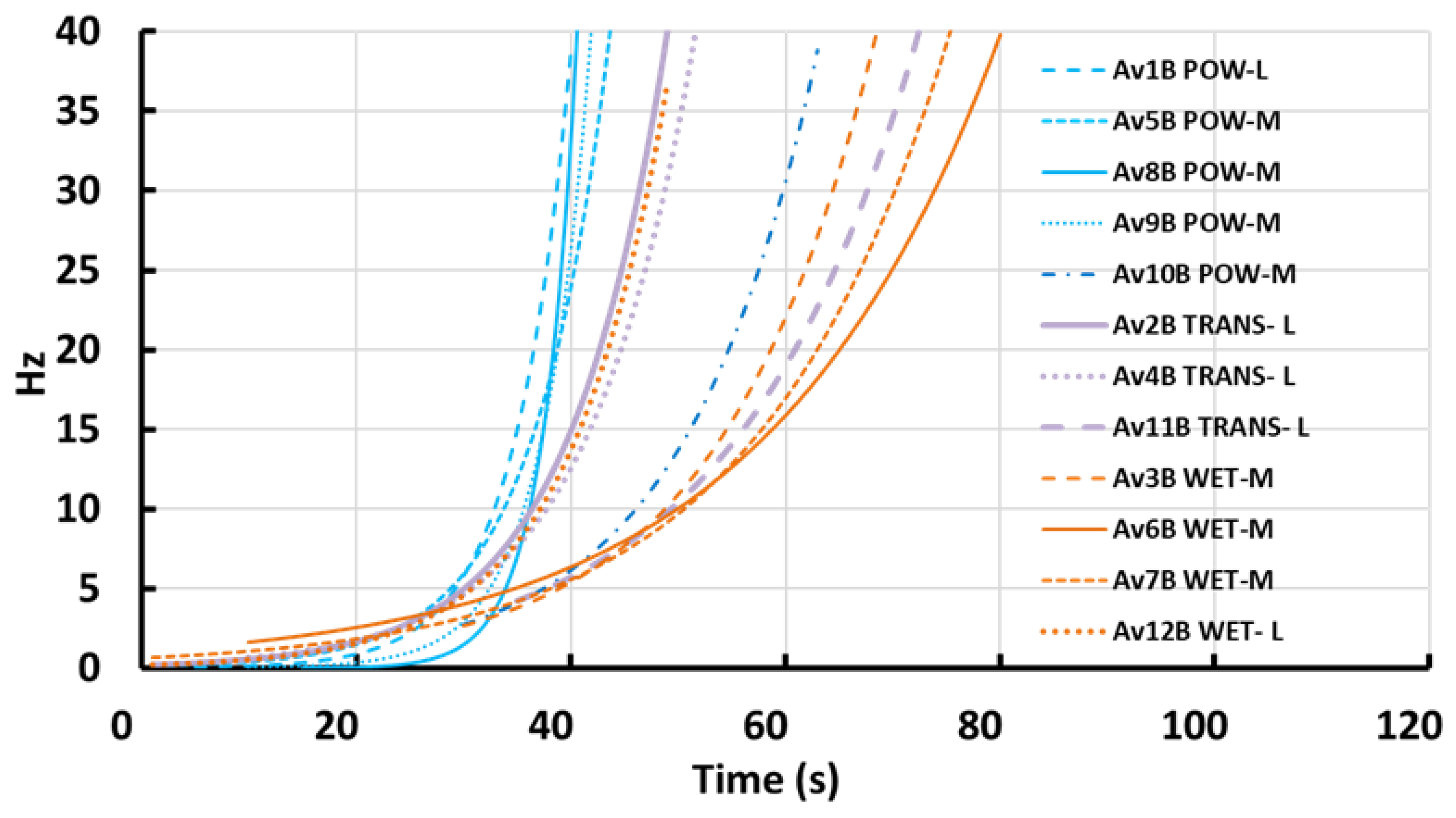
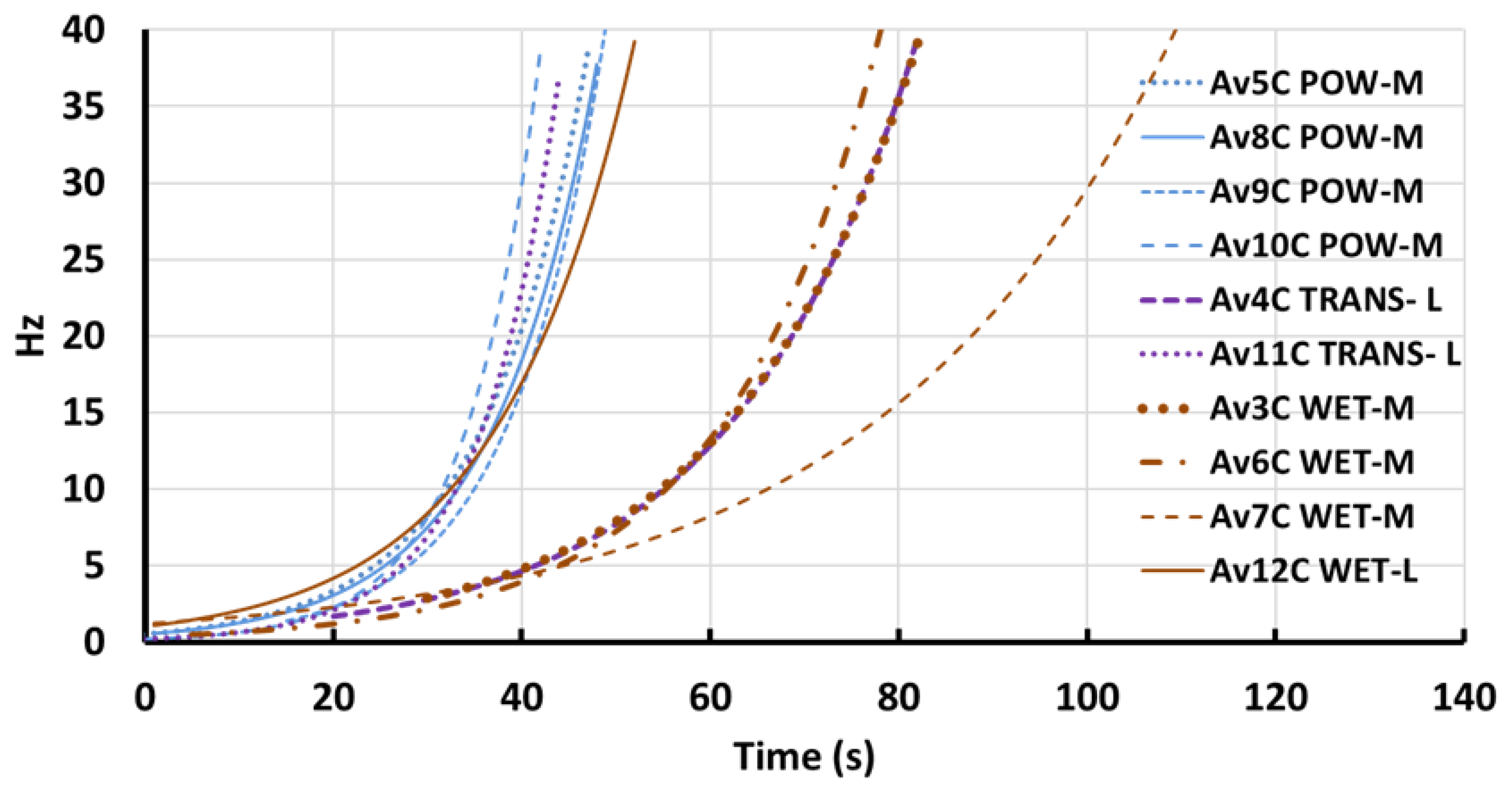
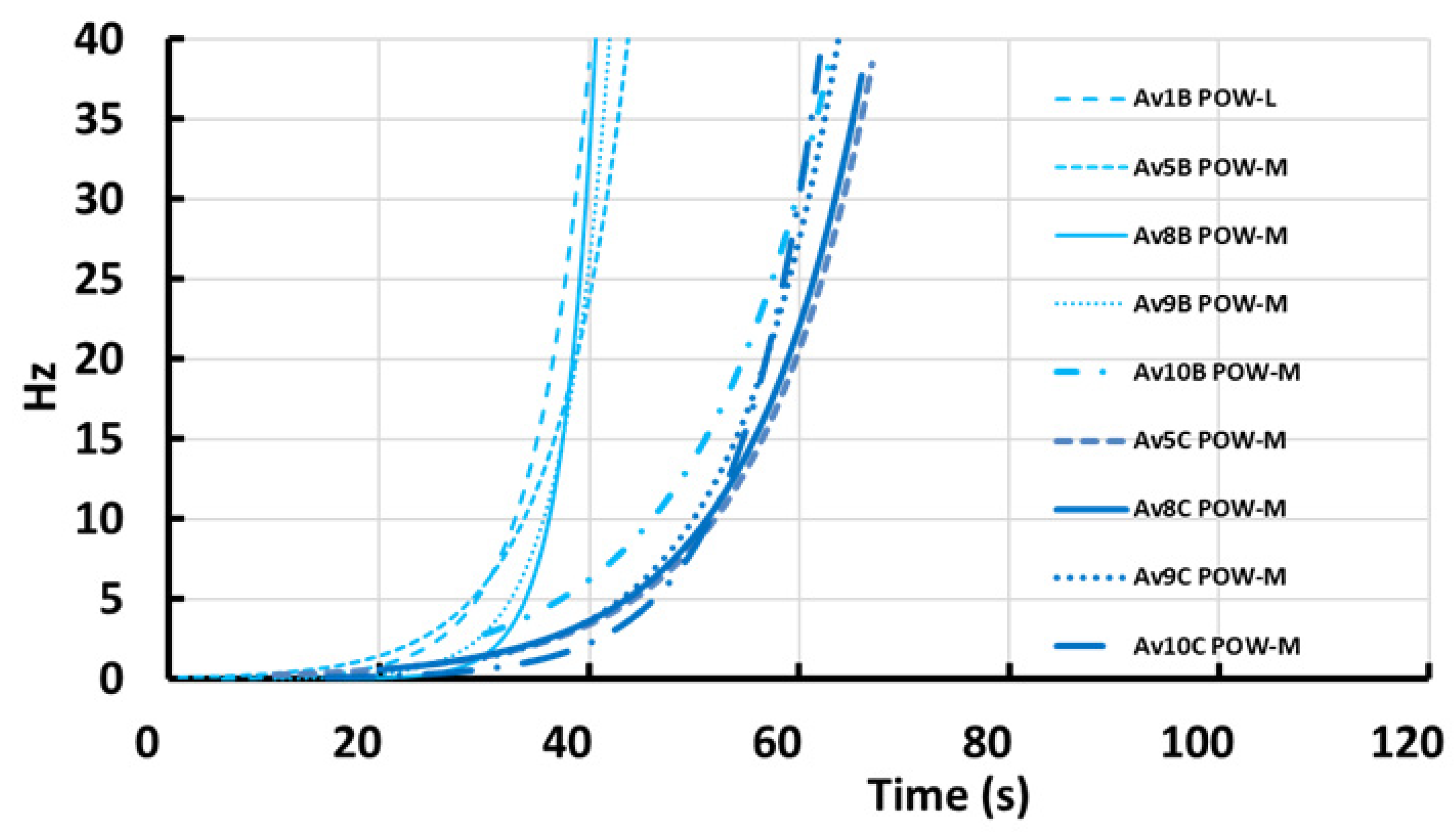
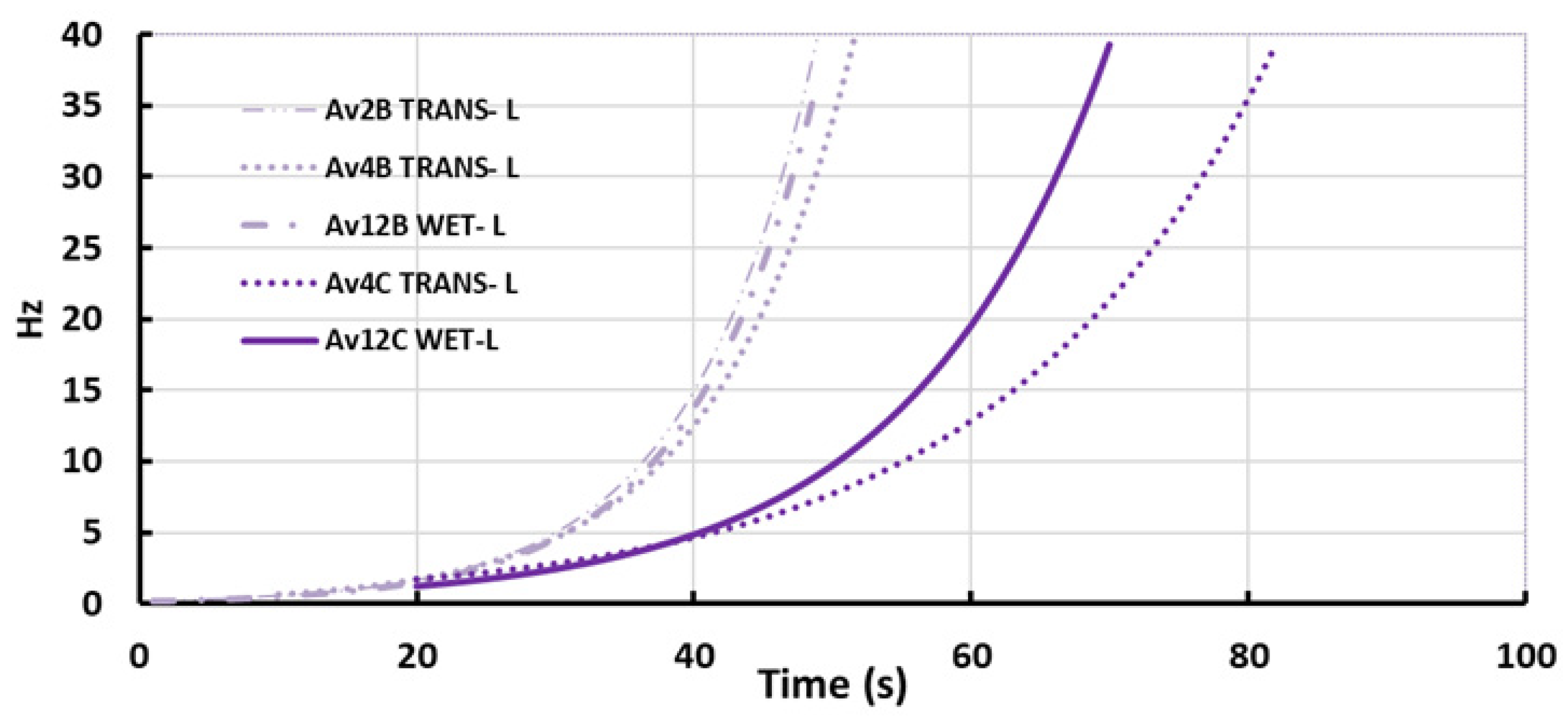
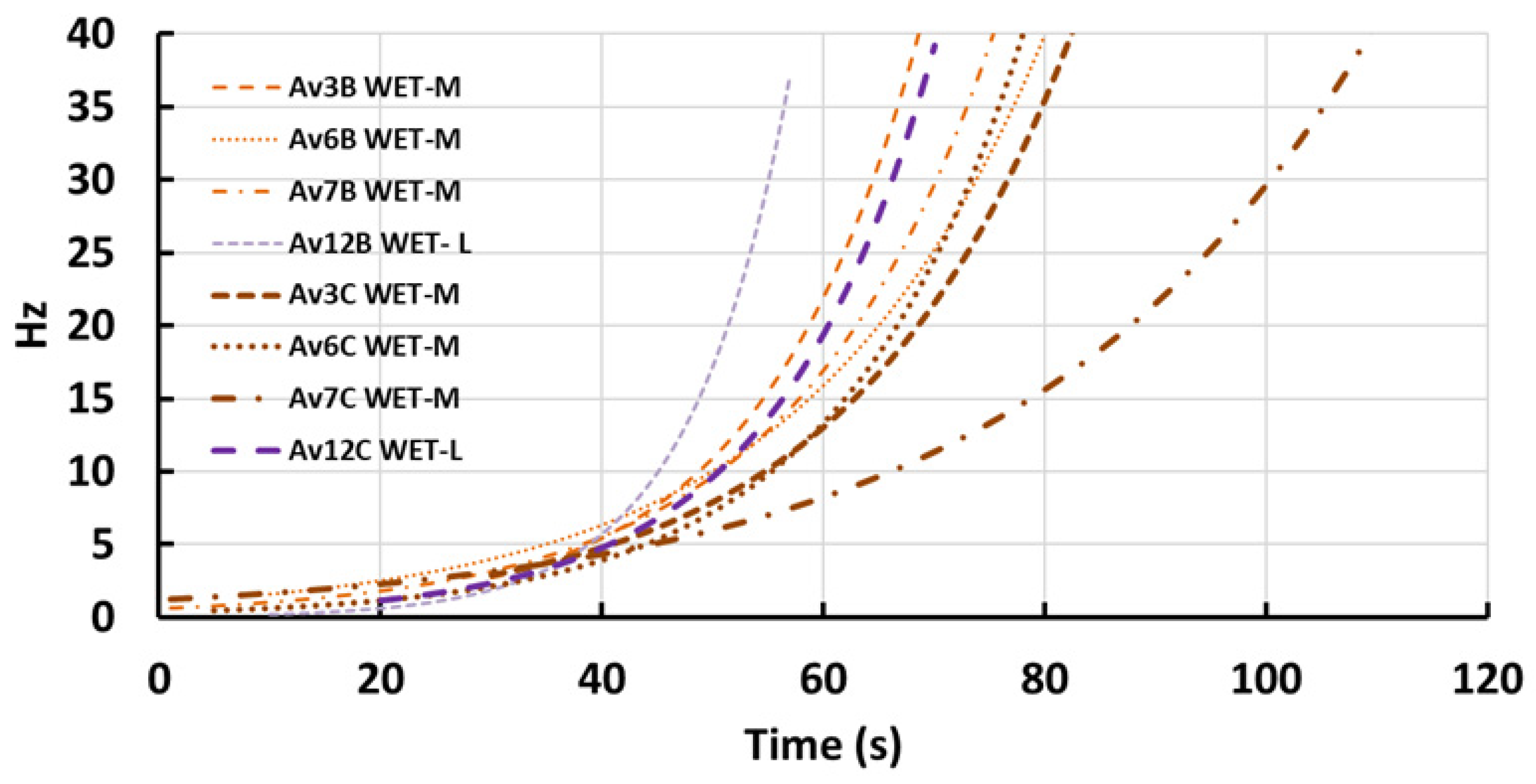

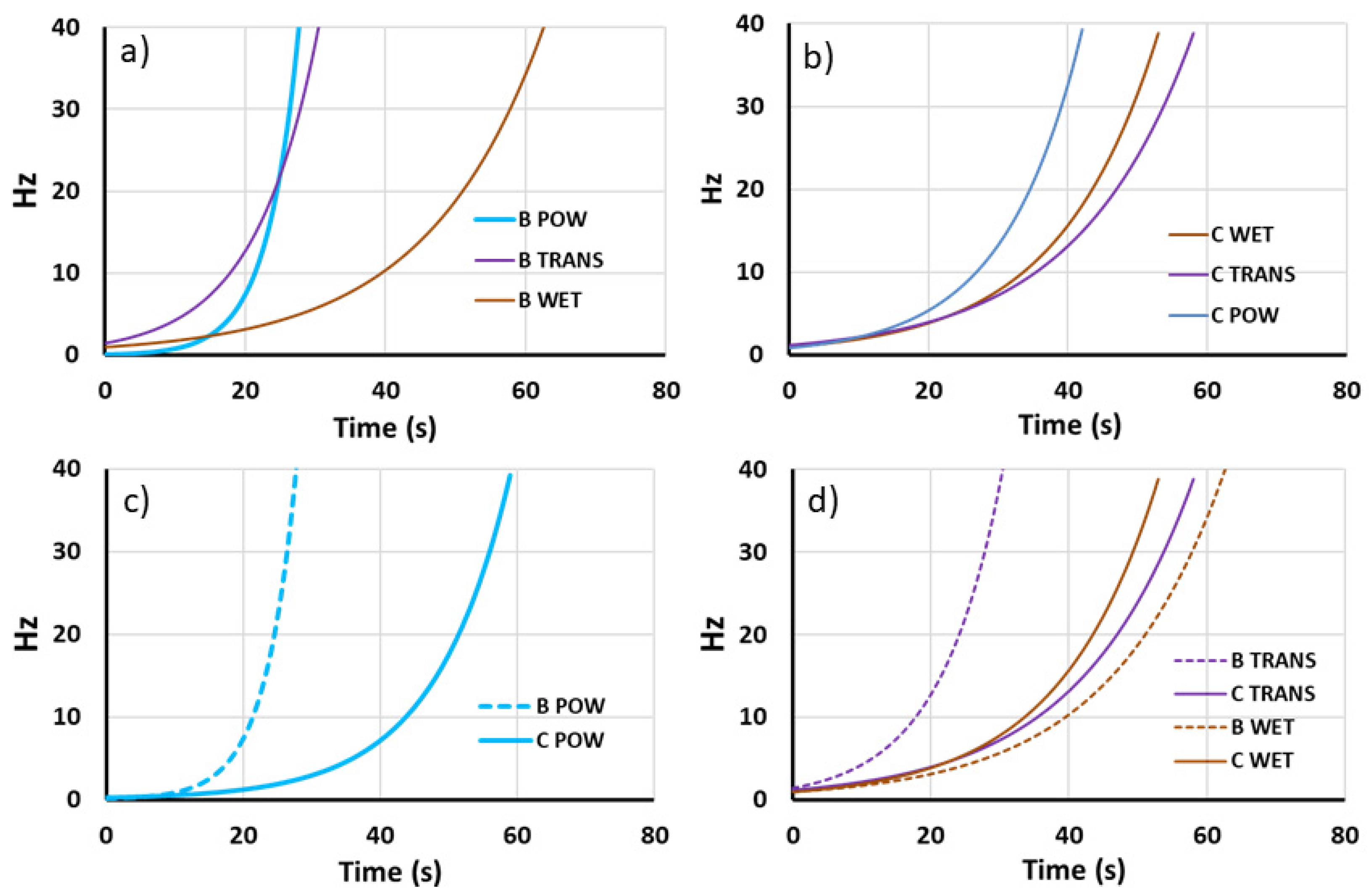
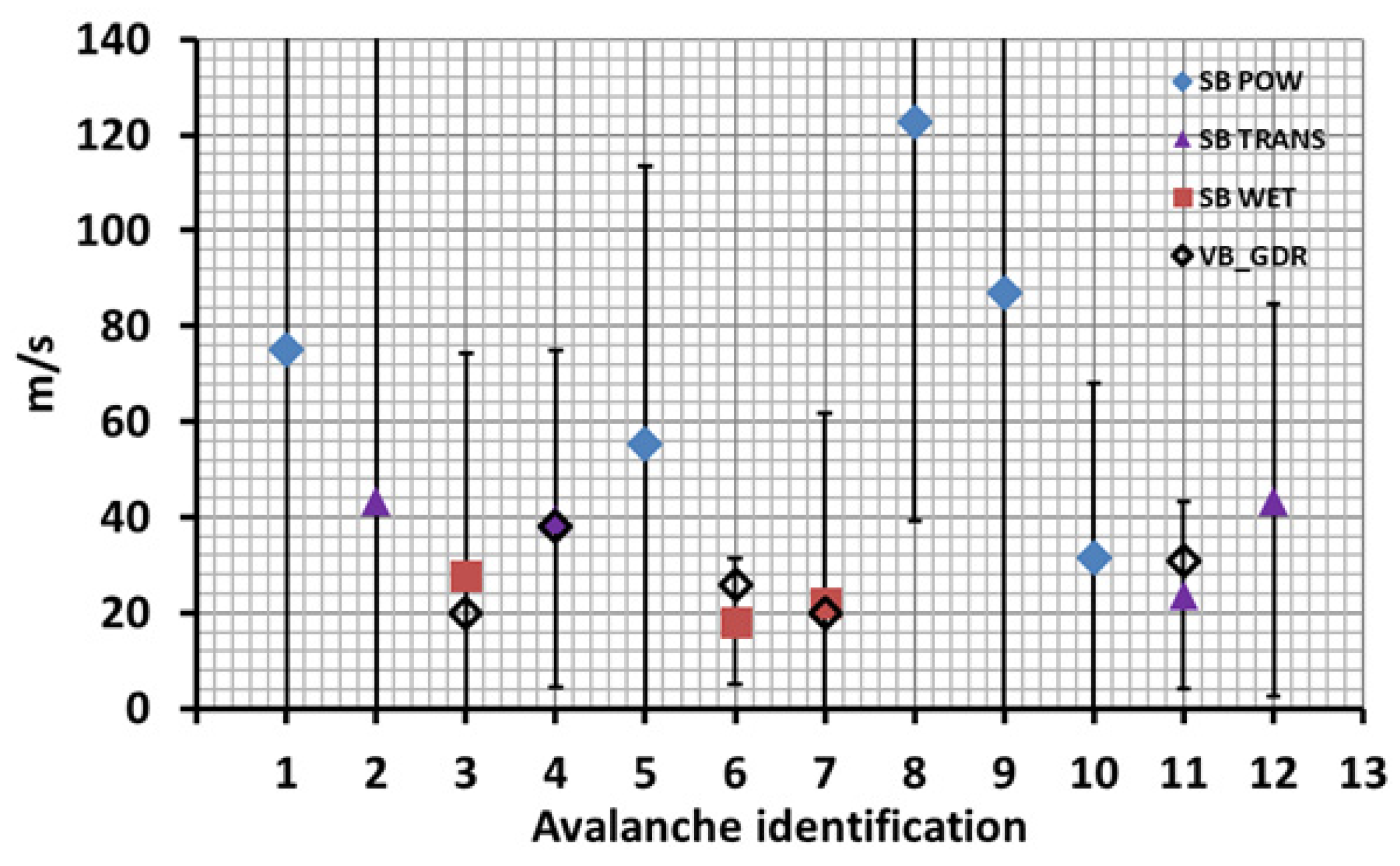
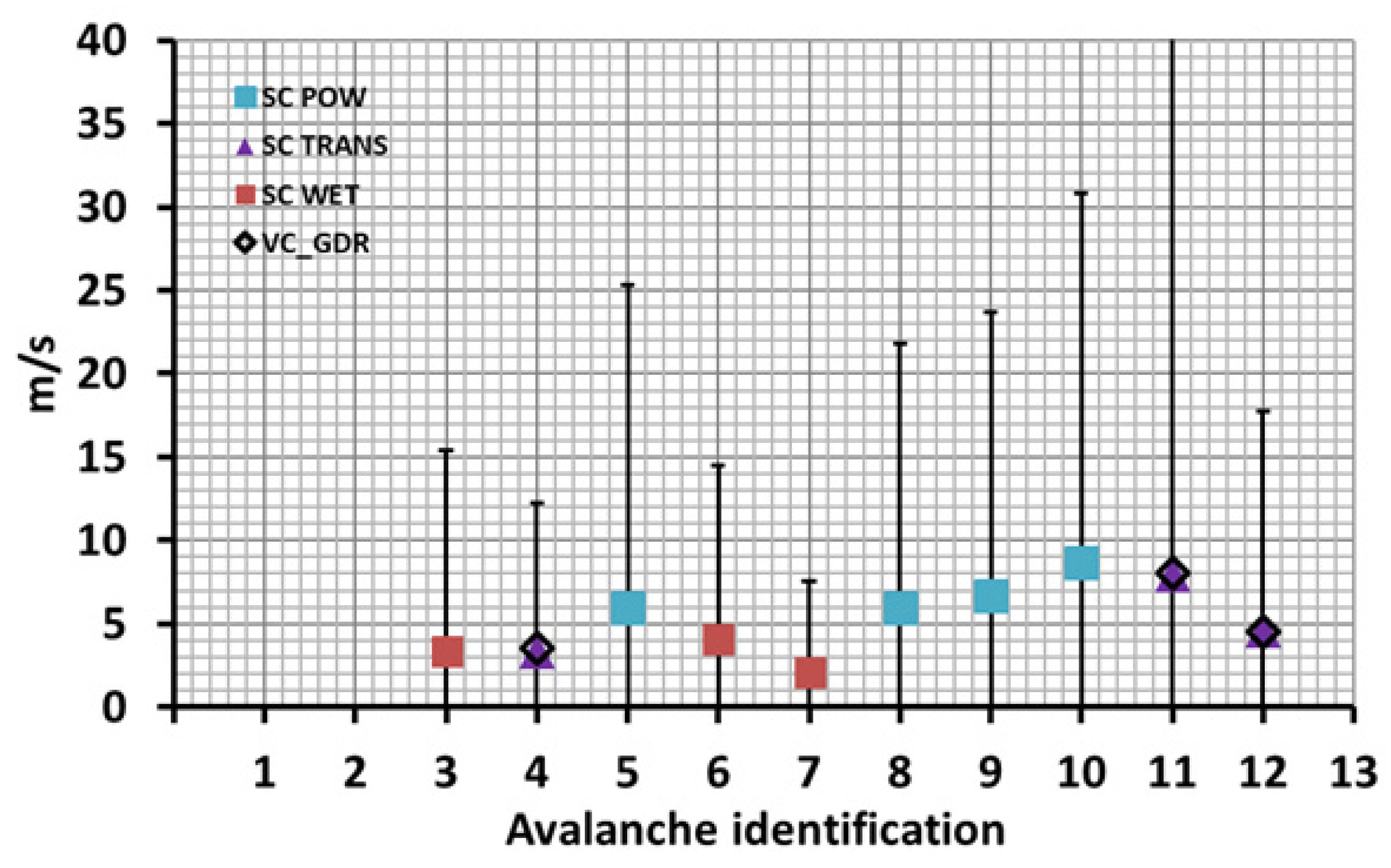
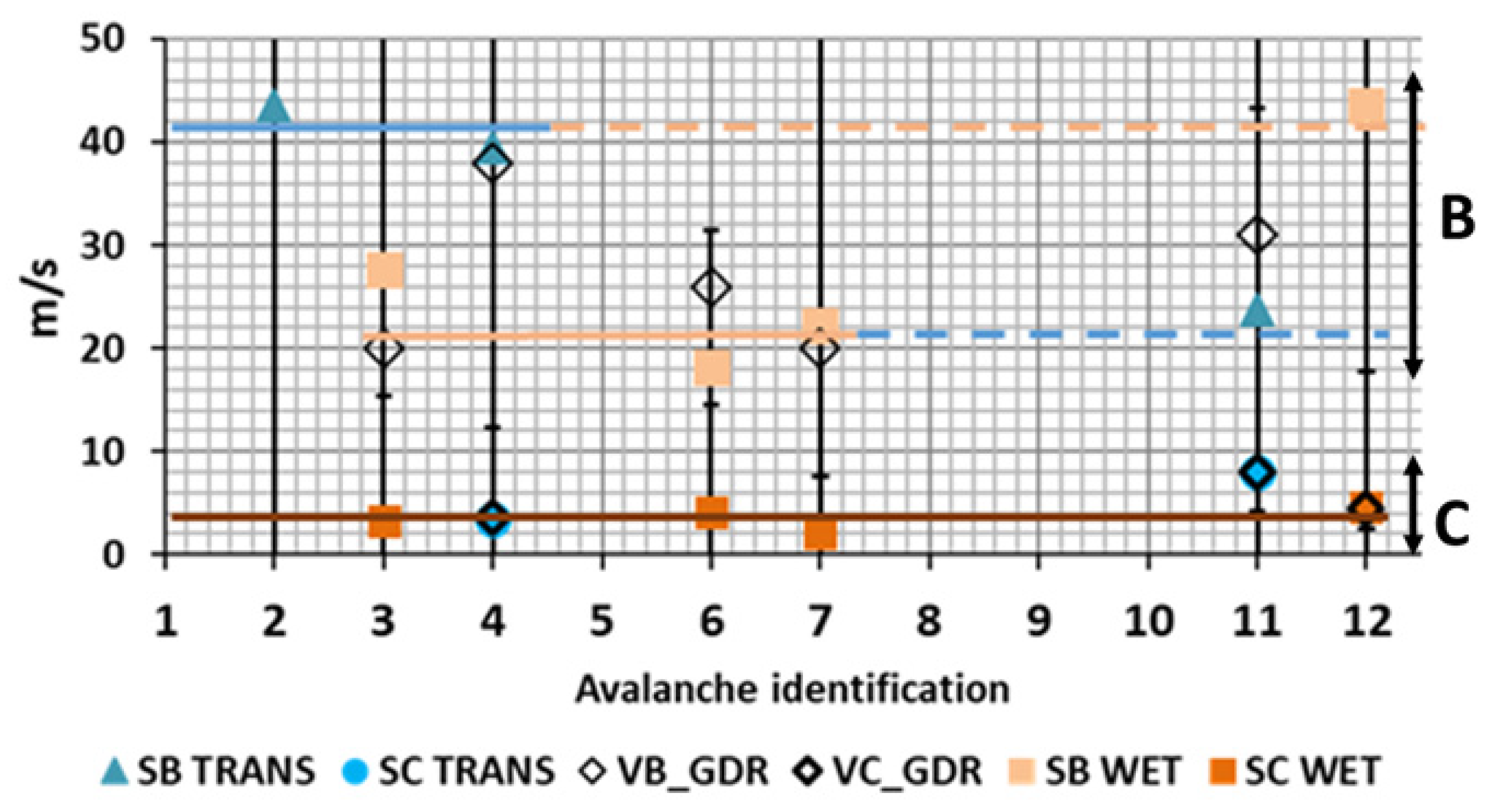
| Aval. N.- Type- Size | Date | Nº | Release Location | Runout [m] | GEODAR | Snow Cover at B [m] | Snow Cover at C [m] |
|---|---|---|---|---|---|---|---|
| Av1 POW-L (A) | 31.01.03 | 504 | Pra–CB1 | 2200 | - | [3–1.5] | - |
| Av2 TRANS (+) | 30.12.09 | 210_0003 | CB1 | 2000 | - | ||
| Av3 WET-M | 01.02.13 | 3018 | CB1 | 1000 | B&900 | [5.5–4.6] | - |
| Av4 TRANS- L | 01.02.13 | 3019 | CB1 | 1900 | B&C | [5.5–4] | [1.75–0.5] |
| Av5 POW- L | 05.02.13 | 3024 | CB1 | 1800 | B&C | 4.2 | - |
| Av6 WET-M | 13.04.13 | 3050 | CB1 | 1200 | B&1000 | 1.5 | - |
| Av7 WET-M | 14.04.13 | 3053 | CB1 | 1300 | B&950 | 2 | - |
| Av8 POW-L (A) | 03.02.15 | 17 | CB1 | 2000 | B&C | [2–0] | [3.5–2.5] |
| Av9 POW-M | 17.12.11 | 3012 | - | 1300 | - | [3.5–1.5] | [3.5–2.5] |
| Av10 POW-S | 30.12.11 | 3023 | Pra-CB1 | 1000 | 1200&650 | [x–4.25] | - |
| Av11 TRANS-L | 02.02.13 | 3021 | CB1-CB2 | 1800 | B&C | [x–4] | [1.5–0.5] |
| Av12 WET-L | 01.02.13 | 3020 | CB1-CB2 | 2000 | 1300&C | [4.5–4] |
| Site B | Site C | |||||
|---|---|---|---|---|---|---|
| Type | K’B(s−1) | β B(s−1) | σβB (s−1) | K’C(s−1) | β C(s−1) | σβC(s−1) |
| Av1 POW-L | 1.04 | 0.19 | 0.68 | |||
| Av2 TRANS-WET | 1.33 | 0.11 | 0.48 | |||
| Av3 WET-M | 14.44 | 0.07 | 0.11 | 411.58 | 0.05 | 0.13 |
| Av4 TRANS- L | 3.10 | 0.10 | 0.07 | 12.18 | 0.05 | 0.03 |
| Av5 POW-L | 1.09 | 0.14 | 0.12 | 1.26 | 0.09 | 0.18 |
| Av6 WET-M | 3.32 | 0.05 | 0.02 | 2.72 | 0.06 | 0.02 |
| Av7 WET-M | 46.53 | 0.06 | 0.09 | 4.48 | 0.03 | 0.01 |
| Av8 POW-L | 2.01 | 0.31 | 0.10 | 3.32 | 0.09 | 0.07 |
| Av9 POW-M | 1.20 | 0.22 | 0.26 | 24.78 | 0.10 | 0.03 |
| Av10 POW-S | 66171.16 | 0.08 | 0.08 | 1.02 | 0.13 | 0.05 |
| Av11 TRANS-L | 403.43 | 0.06 | 0.03 | 1.01 | 0.12 | 0.90 |
| Av12 WET-L | 1.22 | 0.11 | 0.08 | 1211.97 | 0.07 | 0.09 |
| AVALANCHE TYPE | VBGDR (m/s) | SBap (m/s) | SBa (m/s) | VCGDR (m/s) | SCap (m/s) | SCa (m/s) | αi (B) (m−1) | αi (C) (m−1) |
|---|---|---|---|---|---|---|---|---|
| Av1 POW-L | 54 ± 194 | 75 ± 273 | ||||||
| Av2 TRANS- | 31 ± 136 | 44 ± 192 | ||||||
| Av3 WET-M | 20 ± 2 | 20 ± 32 | 28 ± 47 | 5 ± 17 | 3 ± 12 | 0.004 ± 0.006 | ||
| Av4 TRANS- L | 38 ± 4 | 28 ± 21 | 40 ± 35 | 4 ± 0.4 | 5 ± 11 | 3 ± 9 | 0.003 ± 0.002 | 0.015 ± 0.009 |
| Av5 POW- M | 31 ± 3 | 40 ± 37 | 55 ± 58 | 26 ± 3 | 9 ± 26 | 6 ± 19 | 0.005 ± 0.004 | 0.003 ± 0.007 |
| Av6 WET-M | 26 ± 3 | 13 ± 7 | 18 ± 13 | 6 ± 13 | 4 ± 10 | 0.002 ± 0.001 | ||
| Av7 WET-M | 20 ± 2 | 16 ± 27 | 22 ± 39 | 3 ± 7 | 2 ± 5 | 0.003 ± 0.005 | ||
| Av8 POW-L | 41 ± 4 | 88 ± 42 | 123 ± 84 | 26 ± 3 | 9 ± 20 | 6 ± 16 | 0.008 ± 0.003 | 0.003 ± 0.003 |
| Av9 POW-M | 62 ± 77 | 87 ± 115 | 10 ± 22 | 7 ± 17 | ||||
| Av10 POW-S | 23 ± 24 | 32 ± 36 | 13 ± 1 | 13 ± 28 | 9 ± 22 | 0.01 ± 0.004 | ||
| Av11 TRANS-L | 31 ± 3 | 17 ± 11 | 24 ± 20 | 8 ± 1 | 12 ± 91 | 8 ± 63 | 0.002 ± 0.001 | 0.01 ± 0.113 |
| Av12 W/TRANS-L | 31 ± 25 | 44 ± 41 | 5 ± 1 | 7 ± 17 | 5 ± 13 | 0.016 ± 0.019 | ||
| αa | 0.004 ± 0.001 | 0.010 ± 0.023 | ||||||
| αe | 0.0025 ± 0.0015 | 0.015 ± 0.038 |
| Type | K’mB (s−1) | σK’mB (s−1) | ϐmB (s−1) | σϐmB (s−1) | K’mC (s−1) | σK’Mc (s−1) | ϐmC (s−1) | σϐmC (s−1) | E | σ |
|---|---|---|---|---|---|---|---|---|---|---|
| POW | 1.34 | 0.79 | 0.22 | 0.47 | 9.79 | 18.42 | 0.09 | 0.11 | 0.43 | 1.45 |
| TRANS | 2.21 | 1.25 | 0.11 | 0.29 | 12.18 | 0.05 | 0.03 | 0.49 | 1.60 | |
| WET | 21.40 | 31.73 | 0.06 | 0.07 | 139.59 | 333.12 | 0.05 | 0.09 | 0.83 | 2.61 |
© 2020 by the authors. Licensee MDPI, Basel, Switzerland. This article is an open access article distributed under the terms and conditions of the Creative Commons Attribution (CC BY) license (http://creativecommons.org/licenses/by/4.0/).
Share and Cite
Suriñach, E.; Flores-Márquez, E.L.; Roig-Lafon, P.; Furdada, G.; Tapia, M. Estimation of Avalanche Development and Frontal Velocities Based on the Spectrogram of the Seismic Signals Generated at the Vallée de la Sionne Test Site. Geosciences 2020, 10, 113. https://doi.org/10.3390/geosciences10030113
Suriñach E, Flores-Márquez EL, Roig-Lafon P, Furdada G, Tapia M. Estimation of Avalanche Development and Frontal Velocities Based on the Spectrogram of the Seismic Signals Generated at the Vallée de la Sionne Test Site. Geosciences. 2020; 10(3):113. https://doi.org/10.3390/geosciences10030113
Chicago/Turabian StyleSuriñach, Emma, Elsa Leticia Flores-Márquez, Pere Roig-Lafon, Glòria Furdada, and Mar Tapia. 2020. "Estimation of Avalanche Development and Frontal Velocities Based on the Spectrogram of the Seismic Signals Generated at the Vallée de la Sionne Test Site" Geosciences 10, no. 3: 113. https://doi.org/10.3390/geosciences10030113
APA StyleSuriñach, E., Flores-Márquez, E. L., Roig-Lafon, P., Furdada, G., & Tapia, M. (2020). Estimation of Avalanche Development and Frontal Velocities Based on the Spectrogram of the Seismic Signals Generated at the Vallée de la Sionne Test Site. Geosciences, 10(3), 113. https://doi.org/10.3390/geosciences10030113





